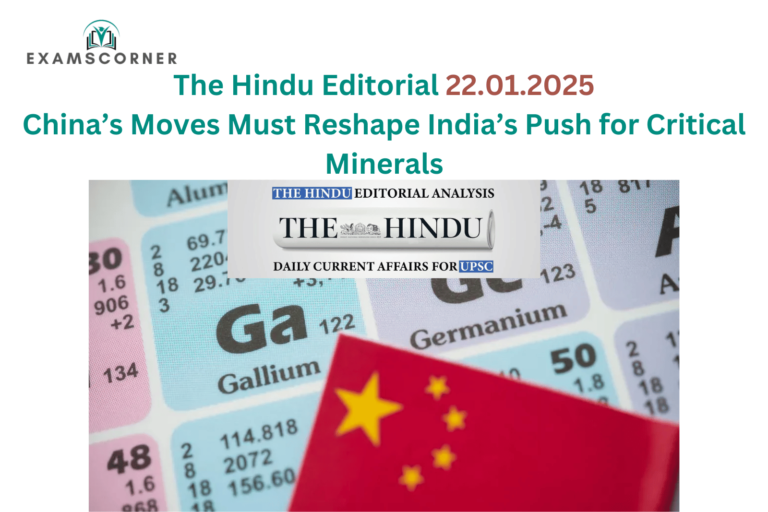Introduction
On January 2, 2025, China’s Ministry of Commerce (MOFCOM) escalated its export control measures, adding 28 U.S. entities to its restricted list. These entities now face limited access to critical minerals and rare materials essential for cutting-edge technologies in aerospace, semiconductors, advanced electronics, and batteries. The restrictions include tungsten, gallium, magnesium, beryllium, hafnium, and lithium-6 isotope—key components for high-tech applications.
As China tightens its grip on critical minerals, the global race to secure these resources intensifies, putting nations like India at a crossroads. India must act swiftly to bolster its domestic capabilities and overcome persistent challenges in critical mineral development.
China’s Strategy: Weaponizing Critical Minerals
China’s approach to critical minerals is both calculated and strategic, targeting materials crucial to Western nations and their allies. The focus often revolves around minerals used in semiconductors, batteries, and high-tech manufacturing.
However, Beijing balances its restrictions with two key considerations:
- Avoiding disruptions to domestic industries reliant on Western raw materials.
- Minimizing negative impacts on export-dependent sectors.
This strategy is not new. In 2010, China imposed a rare earth minerals embargo against Japan. Similarly, its recent restrictions on gallium, germanium, and antimony exports follow a similar pattern. By December 2023, Beijing even banned rare earth extraction and processing technologies, further consolidating its dominance in the sector.
India’s Struggles with Critical Minerals Development
While nations like the U.S. scramble to reduce their dependence on Chinese resources, India’s efforts to enhance critical mineral production face multiple challenges.
- Unrealized Potential:
The discovery of lithium deposits in Jammu and Kashmir’s Reasi district in 2023 was seen as a turning point for India’s energy transition. However, over a year later, these deposits remain unutilized, with no companies stepping forward to bid for them. - Auction Stalemates:
Government data reveals a lack of interest in mineral block auctions. Out of 49 blocks available in recent years, only 24 were successfully auctioned, reflecting the tepid market response.
Government Initiatives to Spur Development
To address these challenges, the Indian government has implemented various measures:
- Identification of Critical Minerals: The Ministry of Mines identified 30 minerals vital to national security.
- International Collaborations: The establishment of Khanij Bidesh India Ltd. (KABIL) aims to secure overseas investments in critical minerals like lithium and cobalt.
- Policy Reforms: The Mines and Minerals (Development and Regulation) Amendment Act, 2023, lifted restrictive classifications on rare earth elements, opening opportunities for private-sector involvement and foreign partnerships.
Exploration Licenses: A Key Reform
The 2023 amendments introduced exploration licenses to attract specialized agencies, including foreign firms. These licenses allow companies to focus on reconnaissance and prospecting without committing to long-term mining operations. Additionally, the government promised to reimburse 50% of exploration costs once mining begins, intending to de-risk initial investments.
However, the impact of these reforms has been underwhelming. Only a few exploration licenses have been granted, mostly to Indian public sector entities. Private and foreign participation remains sparse, and mining license auctions for critical minerals have largely stalled.
Challenges Hindering Progress
- Outdated Resource Classification:
India’s resource classification system often leaves miners uncertain about the commercial viability of mineral blocks. Many auctioned blocks lack advanced exploration data, making them riskier investments. - Low Demand for Exploration Licenses:
Despite the introduction of de-risking mechanisms, interest in exploration licenses remains minimal. - Data Deficiency:
High-quality geological surveys are crucial to overcoming information asymmetry between bidders and the government. Without detailed data, potential investors undervalue or overlook mineral blocks.
Learning from Semiconductor Policy
India’s semiconductor fabrication strategy offers a potential solution for its critical minerals sector. Semiconductor manufacturing requires significant upfront investment with long-term returns, much like mineral exploration. Recognizing this, India has pledged direct capital support during the early stages of chip manufacturing projects.
Applying this model to critical minerals could transform the sector:
- Providing upfront fiscal incentives during the exploration phase would lower investment risks.
- Early-stage funding could attract both domestic and foreign players, unlocking downstream value in mining, exports, and manufacturing.
Conclusion
China’s aggressive control over critical minerals underscores the urgency for India to strengthen its domestic production capabilities. While policy reforms are a step in the right direction, outdated classifications, limited geological data, and insufficient fiscal incentives have hindered progress.
To compete on the global stage, India must recast its critical minerals strategy by adopting the semiconductor fabrication model. Upfront capital support for exploration, combined with robust geological surveys and targeted incentives, could bridge the gap between policy and action. The stakes are high, and India cannot afford to lag behind in the race for critical mineral independence.



